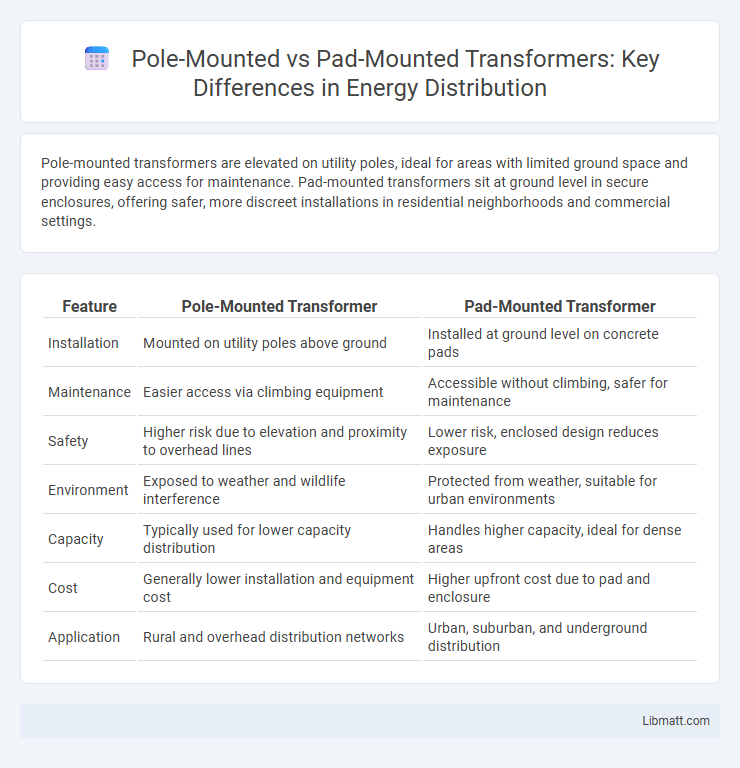Pole-mounted transformers are elevated on utility poles, ideal for areas with limited ground space and providing easy access for maintenance. Pad-mounted transformers sit at ground level in secure enclosures, offering safer, more discreet installations in residential neighborhoods and commercial settings.
Table of Comparison
| Feature | Pole-Mounted Transformer | Pad-Mounted Transformer |
|---|---|---|
| Installation | Mounted on utility poles above ground | Installed at ground level on concrete pads |
| Maintenance | Easier access via climbing equipment | Accessible without climbing, safer for maintenance |
| Safety | Higher risk due to elevation and proximity to overhead lines | Lower risk, enclosed design reduces exposure |
| Environment | Exposed to weather and wildlife interference | Protected from weather, suitable for urban environments |
| Capacity | Typically used for lower capacity distribution | Handles higher capacity, ideal for dense areas |
| Cost | Generally lower installation and equipment cost | Higher upfront cost due to pad and enclosure |
| Application | Rural and overhead distribution networks | Urban, suburban, and underground distribution |
Overview of Pole-Mounted and Pad-Mounted Transformers
Pole-mounted transformers are installed on utility poles, typically found in rural or suburban areas, providing efficient power distribution by elevating equipment for safety and space-saving. Pad-mounted transformers are ground-based, enclosed in secure, weather-resistant cabinets, commonly used in urban and residential neighborhoods for underground electrical systems. Both types serve to step down high-voltage electricity to lower voltages suitable for consumer use, with installation choices influenced by infrastructure, location, and safety requirements.
Key Differences Between Pole-Mounted and Pad-Mounted Transformers
Pole-mounted transformers are installed on utility poles, providing elevated placement ideal for areas with limited ground space, while pad-mounted transformers sit on concrete pads at ground level for easier access and maintenance in urban or suburban settings. Your choice depends on factors like space availability, safety considerations, and aesthetic preferences, as pad-mounted transformers are more visually discreet and safer in populated areas compared to the exposed pole-mounted types. Key differences also include installation costs, with pole-mounted transformers typically cheaper but more exposed to weather and vandalism risks than the sturdier, enclosed pad-mounted options.
Construction and Design Comparison
Pole-mounted transformers feature a compact, cylindrical design mounted on utility poles, making them ideal for overhead electrical distribution in residential and rural areas. Pad-mounted transformers have a robust, metal-enclosed, ground-level design with secure locking features, suited for underground distribution systems in urban and suburban environments. Both designs use oil-filled insulation but differ significantly in accessibility and protection against environmental factors and vandalism.
Installation Requirements and Location Suitability
Pole-mounted transformers require elevated installation on utility poles, making them ideal for rural or suburban areas with limited ground space and overhead power lines. Pad-mounted transformers are installed at ground level on concrete pads, suitable for urban or residential neighborhoods where underground power distribution and easy access for maintenance are prioritized. The choice depends on factors like available space, safety regulations, and aesthetic considerations.
Power Capacity and Load Handling
Pole-mounted transformers typically support lower power capacities ranging from 5 kVA to 50 kVA, making them ideal for light to medium residential load handling. Pad-mounted transformers offer higher power capacities, often exceeding 300 kVA, enabling them to efficiently manage heavy commercial and industrial loads. The difference in load handling capability is driven by design and installation, with pad-mounted transformers providing enhanced cooling and easier access for maintenance in high-demand applications.
Safety and Accessibility Considerations
Pole-mounted transformers are installed above ground on utility poles, enhancing safety by minimizing the risk of accidental contact but requiring specialized equipment for maintenance, which can limit accessibility. Pad-mounted transformers rest on ground-level concrete pads, offering easier access for routine inspections and repairs while incorporating locked enclosures to ensure public safety. Both transformer types utilize robust insulation and protective barriers to comply with industry safety standards, but their placement significantly influences maintenance efficiency and hazard exposure.
Maintenance and Longevity Factors
Pole-mounted transformers generally require more frequent maintenance due to their exposure to weather conditions and potential physical damage, impacting their longevity. Pad-mounted transformers benefit from ground-level installation that simplifies inspection and repairs, reducing downtime and maintenance costs. Materials and protective designs in pad-mounted units enhance durability compared to pole-mounted transformers, often resulting in longer operational lifespans.
Cost Analysis: Upfront and Long-Term Expenses
Pole-mounted transformers generally have lower upfront costs due to simpler installation on existing utility poles, but their maintenance expenses can increase over time because of exposure to weather and potential damage. Pad-mounted transformers involve higher initial investment for site preparation and installation but offer reduced long-term maintenance costs and enhanced safety features. Evaluating your project's budget requires balancing these upfront savings against potential long-term expenses to determine the most cost-effective transformer type.
Applications and Use Cases
Pole-mounted transformers are commonly used in rural or suburban areas where overhead power lines are prevalent, providing electricity to homes and businesses with limited space for ground-based equipment. Pad-mounted transformers are ideal for urban and residential neighborhoods with underground power distribution, offering safety and aesthetic benefits by being enclosed at ground level. Your choice between these transformers depends on the infrastructure design and environmental constraints of the installation site.
Choosing the Right Transformer for Your Project
Pole-mounted transformers are ideal for rural or suburban areas where space constraints and ease of maintenance are critical, offering elevated protection from flooding and physical damage. Pad-mounted transformers suit urban and residential projects requiring underground distribution, providing enhanced safety and aesthetic integration with surroundings. Evaluate site-specific factors such as terrain, accessibility, and electrical load to select the most efficient transformer type for your project's energy distribution needs.
Pole-mounted transformer vs Pad-mounted transformer Infographic

 libmatt.com
libmatt.com